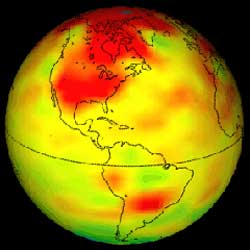Northeastern researcher finds missing atmospheric carbon dioxide

Northeastern environmental scientist finding could improve global warming forecast models
A Northeastern University researcher today announced that he has found that the soil below oak trees exposed to elevated levels of carbon dioxide had significantly higher carbon levels than those exposed to ambient carbon levels. The findings are consistent with the hypothesis that elevated carbon dioxide levels are increasing carbon storage in terrestrial ecosystems and slowing the build-up of carbon dioxide levels in the atmosphere. Carbon dioxide is thought to cause global warming by trapping heat radiated by the Earth.
The research, published in the latest on-line edition of the journal Earth Interactions, represents an important advance in the global warming research. The lead author on the article, “Soil C Accumulation in a White Oak CO2-Enrichment Experiment via Enhanced Root Production,” is Kevin G. Harrison from the department of earth and environmental sciences at Northeastern. Contributors also include Richard J. Norby and Wilfred M. Post from the Oak Ridge National Library in Tennessee and Emily L. Chapp form the University of Hawaii.
In the study, the researchers sought to determine if the mechanism for storing carbon in soil was CO2 fertilization, the process by which plants grow better when exposed to high CO2 levels, and to investigate the extent to which CO2 fertilization could be increasing the amount of carbon stored in soil under white oak trees. The researchers studied the soil below white oak trees in the temperate zone over four growing seasons and found that the soil below trees exposed to elevated levels of CO2 had an average of 14% more carbon.
“Researchers have long been puzzled by observations that show that carbon dioxide levels in the atmosphere are increasing more slowly than expected.,” said Harrison. “This conundrum has hindered predictions of future carbon dioxide levels and, in turn, estimates of future global warming. By being able to demonstrate a substantial average increase in the carbon below these oak trees, we have potentially found the solution to better global warming forecasting. However, further research is needed in other ecosystems to see if they show similar responses to elevated carbon dioxide levels.”
Media Contact
More Information:
http://www.neu.eduAll latest news from the category: Ecology, The Environment and Conservation
This complex theme deals primarily with interactions between organisms and the environmental factors that impact them, but to a greater extent between individual inanimate environmental factors.
innovations-report offers informative reports and articles on topics such as climate protection, landscape conservation, ecological systems, wildlife and nature parks and ecosystem efficiency and balance.
Newest articles

Microscopic basis of a new form of quantum magnetism
Not all magnets are the same. When we think of magnetism, we often think of magnets that stick to a refrigerator’s door. For these types of magnets, the electronic interactions…

An epigenome editing toolkit to dissect the mechanisms of gene regulation
A study from the Hackett group at EMBL Rome led to the development of a powerful epigenetic editing technology, which unlocks the ability to precisely program chromatin modifications. Understanding how…

NASA selects UF mission to better track the Earth’s water and ice
NASA has selected a team of University of Florida aerospace engineers to pursue a groundbreaking $12 million mission aimed at improving the way we track changes in Earth’s structures, such…





















